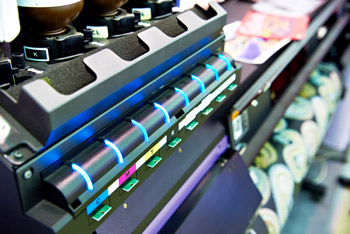
Textile printing can be challenging as there are more variables throughout the process that can impact the final product. Paper (when printing with dye-sublimation transfer), fabrics, inks, and heat presses all have variables that need to be understood and managed for outstanding printing to occur. Let’s look at these top four areas to address when printing textiles.
Paper
Dye-sublimation transfer printing relies heavily on paper as the first variable to master for excellent printing. Having a dialed-in profile with reasonable ink limits
will make or break your printing process right from the start. Most profiles I’ve seen have the ink limits set far too high, and a considerable amount of ink is left on the paper after sublimating, which means money is being thrown into the
garbage can. Also, ink limits set too high can cause the end user to choose a heavier paper than necessary, which is another unnecessary expense.
Take time to learn how to profile your printers for great results when printing to textiles, mainly when using paper as part of the transfer process. Lastly, make sure you are using paper especially designed for fabric instead of paper that is more effective
for hard surface transfers.
Fabric
Fabrics can provide a few challenges, and I will focus on two crucial aspects for the end user to address. The first is optical brightening agents (OBAs), which are present
in almost all fabrics. Simply put, OBAs make the material appear whiter when they are excited by UV light. Think about ads for laundry detergent that mention bluing agents for “whiter whites,” and you’ll understand when I say that
a spectrophotometer taking a reading from fabric will show a trend toward blue. Our eyes interpret this as white, and — in a nutshell — that’s what you see, which creates a challenge for color management.
The second issue with fabrics is the tendency to shrink when pressed with heat. You’ll need to print a defined size image (I usually print a rectangular box that is the dimension of the heat press I’m using); print and press it; and then measure the box to see how much the shrink factor is that you will need to put in the RIP software so that it can adjust the image size.
Ink
For best results with inks, you must consider the following: How long can the ink sit on the shelf and still be effective? What are the manufacturer’s recommendations
for the transfer in terms of temperature, time, and pressure? Make sure you know the best results.
Also, how does the ink interact with paper (when used for transfer)? Does it have an efficient release, or is dye left on the paper after transfer? Is the ink compatible with the printhead in the printer? Some will clog more readily if not used in the
recommended printhead. It will help if you investigate these aspects when selecting an ink for textile printing.
Heat Press
Finally, testing the heat press for consistent heat across the entire surface is essential. Look for cold spots or inconsistent heat as a sign that you may need to replace the press.
This is more likely to occur when doing smaller one-offs than larger roll units, but both should be checked for even heat distribution.
Managing these variables will help eliminate many of the challenges that can be a factor in textile printing. To learn even more, join us at the upcoming Digital Textile Printing Conference, presented by PRINTING United Alliance and AATCC on Dec. 7-8, in Raleigh, North Carolina. Learn more about the education and networking this event has to offer — I look forward to seeing you there!

Ray Weiss, VP, eLearning & Certifications, PRINTING United Alliance, assists association members with information on wide-format digital printing as well as equipment, materials, and vendor referrals. He oversees the association's training and certification workshops, and is responsible for both the PDAA training and certification program as well as the new iLEARNING+ platform. Weiss has a background in color management and is a G7 expert. He regularly contributes to the association's Journal and won the 2016 Swormstedt Award for Best in Class writing in the Digital Printing category. Weiss was inducted into the Academy of Screen and Digital Printing Technologies in 2020. Outside of work, Ray is a bicycling enthusiast and enjoys international cuisine, travel, and spending time with his three grandkids.
